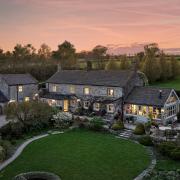Richard Darn takes a trip to the West Yorkshire town full of history and culture

I’ve always regarded Huddersfield as a kind of aboriginal Yorkshire. A heartland if you like where the true soul of the county resides. Perhaps that’s not far from the truth. Did you know for instance that the town was home to the ‘prototype’ Yorkshire Terrier and father of the breed? `Huddersfield Ben` was a handsome mutt – a bit stockier than the modern version – and won many prizes before his untimely death in 1871 under the wheels of a carriage. A taxidermist ensured that Ben’s supermodel looks were preserved as a template for the breed.
And he’s not the only thoroughbred to hail from this ancient Pennine town. One of its most famous sons was Hollywood legend James Mason. That should have been a huge promotional asset. But when the actor made clear how much he hated the place it turned into a PR liability. Happily the star repented and looked beyond the grime to see the town’s inner beauty. In 1972 he made a loving documentary called ‘Home James’ featuring sublime views of chimney stacks and church steeples, cobbled streets, washing lines and bands marching down the road.
But my convictions have always been steady. I am a big fan of this place, listed in the Domesday Book as Oderesfelt, and with roots going back into prehistory. Stand on top of lofty Castle Hill and you not only get breathtaking panoramic views, but you are also perched on an Iron Age Hill Fort, constructed 500 years before the Romans arrived. Topped by the impressive Victoria Tower, the hill has been the scene of political rallies, cock fights and a second world war anti aircraft battery.
For the most dramatic entrance to Huddersfield ditch the car and come by train on the Penistone Line. Snaking its way through spectacular scenery and over three immense viaducts (Penistone, Denby Dale and Lockwood – all listed buildings), it sweeps into town on a curving line revealing the majestic heart of the town.

Your arrival could hardly be grander. Grade I Huddersfield Station with its classical columns opened in 1850 and has been described as a stately home with trains. Two pubs occupy part of the grand complex so it’s also a good watering hole and a destination in itself.
Leaving the station brings you into St George’s Square with its fine buildings. I could gabble on endlessly about architectural splendour. Only two other places in England have more listed buildings than Huddersfield and Friedrich Engels - father of international communism - said it was ‘the handsomest of all the factory towns in Yorkshire and Lancashire’. A statue of Harold Wilson, locally born and bred, looks on admiringly and to the left is the George Hotel (although closed and up for sale as I write), birthplace of Rugby League in 1895.
According to Discover Huddersfield – a local tourism initiative - the town also boasts independent shops, is rich in creativity, stories and heritage and was a hotbed of radicals. And for once the PR lives up to its billing. There is a lot to be proud of here. One family in particular played a huge role in the town’s development. William Ramsden bought the Manor of Huddersfield from Queen Elizabeth in 1599, which his descendants held until they sold out to the council in 1921 for the tidy sum of £1.3m.
The railway station, St George’s Square, Huddersfield Broad Canal and a host of other ventures were financed by the Ramsdens. They even built an inland port at Aspley, with boat-building and rope making industries. It’s now a lively marina just a short stroll from the town centre.

But for all the grandeur there was hardship. Luddites fearing for their jobs roved the area smashing machines and in 1813 a total of 17 local men were hanged in York for their part in killing a Marsden mill owner. Long factory hours for children became a violent flashpoint and troops were also deployed to put down strikers. This is a rich social history and it’s good to see it merits its own themed walking leaflet, although I’m not sure the Sex Pistols (who played their last ever UK gig in the town) warrant the title radical – just naughty boys really.
Harking back to the James Mason documentary the actor lauded Huddersfield’s musical traditions. I had never stopped to think about that before. But he’s right. The town has a worldwide reputation for its Contemporary Music Festival and the magnificent Huddersfield Choral Society was established as long ago as 1836. I’d also never heard of the Mrs Sunderland Music Competition before my latest visit – founded in 1889 and named after a much loved local singer – it continues to give local performers chance to shine, adding yet another string to Huddersfield’s musical bow.
That set me off humming the Messiah as I made my way through the town centre. After a pint at the simply wonderful Slubbers Arms in Fartown – one of many fine real ale venues in town - it was time to get the train home. As I waited on the platform the Manchester bound services came and went, packed to the rafters with gloomy looking commuters. I pitied them - don’t they realise it is much better here?
Find out more about Huddersfield at discoverhuddersfield.com




























